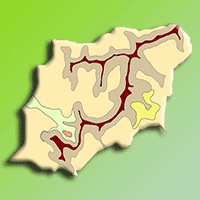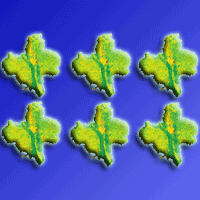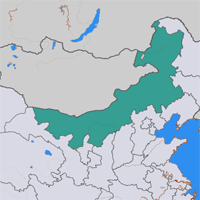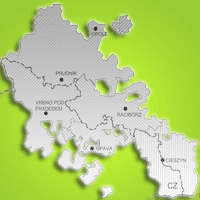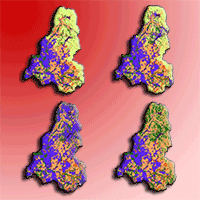
Quantitative assessment of past and future tropical forest transition and its dynamic to streamflow of the catchment, Malaysia
Mahboubeh Ebrahimian (1) , Ahmad Ainuddin Nurruddin (2)
iForest - Biogeosciences and Forestry, Volume 17, Issue 3, Pages 181-191 (2024)
doi: https://doi.org/10.3832/ifor4339-017
Published: Jun 30, 2024 - Copyright © 2024 SISEF
Research Articles
Abstract
The consequences of human interventions on land use have been empirically demonstrated to affect substantially hydrological processes and ecosystem services within watershed environments. Since 1970, Malaysia has faced deforestation, driven mainly by logging and agricultural expansion, aligning with its developmental goals by 2020. From 1970 to 2000, deforestation led to a 25.5% decline in forested land, causing a significant 10.2% rise in excess runoff. Moreover from 2001 to 2021, the nation lost 17% of its total land to deforestation. These trends emphasize the need for a thorough investigation of sustainable conservation efforts in Malaysia. This study focuses on the Langat basin in Malaysia, evaluating past and future land use changes and their effects on the basin’s hydrological response. The study employed key informant reports, population growth data, observed land use change, field survey and agricultural land availability considered for developing change scenarios. We emphasized the significance of integrating diverse modeling methods to analyze LULC changes effectively. The use of a semi-distributed hydrological model, SWAT, in combination with Markov chain and Multi-Layer Perceptron (MLP) model and Geographic Information Systems (GIS) techniques proved to be an integrated and suitable tool for comprehensive change analysis and modeling of land use. Markov chain modeling is valuable for predicting land use changes over time, providing input scenarios for SWAT simulations. MLP is a powerful algorithm to capture non-linear relationships and complex patterns in the data, enhancing the modeling accuracy. The simulation results, based on historic land use data (1984-2006-2010) and projected future land use maps (2030-2050-2080), revealed a consistent pattern of urban expansion and deforestation leading to increased streamflow. Projections indicated a substantial rise in streamflow by 20%, 61%, and 71% for the 2030s, 2050s, and 2080s, respectively. To mitigate potential flood and sediment loss, it is crucial to involve local stakeholders such as local communities, government bodies, environmental organizations, and businesses. Such analysis facilitates understanding their perspectives and concerns regarding afforestation and urban expansion control, informing future development programs and land use planning effectively.
Keywords
Land Use Conversion, Hydrological Processes, Land Use Scenarios, Markov Chain, SWAT
Authors’ Info
Authors’ address
Department of Water Resources Management, Research Institute of Hamoon International Wetland, Zabol Research Institute, Zabol (Iran)
Faculty of Forestry, Universiti Putra Malaysia, 43400 UPM Serdang, Selangor (Malaysia)
Corresponding author
Paper Info
Citation
Ebrahimian M, Nurruddin AA (2024). Quantitative assessment of past and future tropical forest transition and its dynamic to streamflow of the catchment, Malaysia. iForest 17: 181-191. - doi: 10.3832/ifor4339-017
Academic Editor
Luigi Saulino
Paper history
Received: Mar 01, 2023
Accepted: Jun 26, 2024
First online: Jun 30, 2024
Publication Date: Jun 30, 2024
Publication Time: 0.13 months
Copyright Information
© SISEF - The Italian Society of Silviculture and Forest Ecology 2024
Open Access
This article is distributed under the terms of the Creative Commons Attribution-Non Commercial 4.0 International (https://creativecommons.org/licenses/by-nc/4.0/), which permits unrestricted use, distribution, and reproduction in any medium, provided you give appropriate credit to the original author(s) and the source, provide a link to the Creative Commons license, and indicate if changes were made.
Web Metrics
Breakdown by View Type
Article Usage
Total Article Views: 12122
(from publication date up to now)
Breakdown by View Type
HTML Page Views: 8515
Abstract Page Views: 1646
PDF Downloads: 1687
Citation/Reference Downloads: 0
XML Downloads: 274
Web Metrics
Days since publication: 539
Overall contacts: 12122
Avg. contacts per week: 157.43
Citation Metrics
Article Citations
Article citations are based on data periodically collected from the Clarivate Web of Science web site
(last update: Mar 2025)
(No citations were found up to date. Please come back later)
Publication Metrics
by Dimensions ©
Articles citing this article
List of the papers citing this article based on CrossRef Cited-by.
References
SWAT-CUP calibration and uncertainty programs for SWAT. In: Proceedings of the “MODSIM 2007 International Congress on Modelling and Simulation”. Modelling and Simulation Society of Australia and New Zealand, Canberra, Australia, pp. 1596-1602.
Gscholar
Short-term and long-term projection on Malaysian palm oil production. Oil Palm Industry Economic Journal 3 (1): 32-36.
Gscholar
Quantifying the impacts of climate and land use changes on the hydrological response of a monsoonal catchment. PhD thesis, Faculty of Social and Human Sciences, University of Southampton, UK, pp. 273.
Gscholar
SWAT application for hydrologic and water quality modeling for suspended sediments: a case study of Sungai Langat’s catchment in Selangor. In: International conference on water resources, pp. 26-27.
Gscholar
Urban land use and land cover change analysis and modeling a case study area Malatya, Turkey. Master thesis, Westfälische Wilhelms-Universität, Münster, Germany, pp. 75.
Gscholar
Agronomic requirements and management of oil palm for high yields in Malaysia. In: Proceeding of the seminar on managing oil palm for high yields: agronomic principles. Malaysia Society of Soil Science and Param Agriculture Soil Surveys, pp. 39-73.
Gscholar
Deep residual learning for image recognition. In: Proceedings of the “IEEE Conference on Computer Vision and Pattern Recognition.
Gscholar
Integrating forest cover change and carbon storage dynamics: leveraging Google Earth Engine and InVEST model to inform conservation in hilly regions. Ecological Indicators 152 (2): 110374.
CrossRef | Gscholar
The effects of rainforest conversion on water balance, water yield and seasonal flows in a small tropical catchment in Central Sulawesi. In: “Nature Conservation and the Stability of Rainforest Margins in Southeast Asia”. Springer, Berlin, Heidelberg, New York, pp. 353-365.
Gscholar
Forest rehabilitation-the Malaysian experience. Part A: status of land use and forest (and land) degradation. International Union of Forest Research Organizations.
Gscholar
Predicting microscale land use/land cover changes using cellular automata algorithm on the northwest coast of peninsular Malaysia. Earth Systems and Environment 6 (4): 817-835.
CrossRef | Gscholar
Using geographical information systems (GIS) applications in mapping land use changes in the Langat River Basin, Selangor 1974 -2001. In: Proceedings of the “Regional Symposium on Environment and Natural Resources”. Kuala Lumpur (Malaysia) 10-11 Apr 2011, vol. 1, pp. 349-358.
Gscholar
Monitoring and predicting the influences of land use/land cover change on cropland characteristics and drought severity using remote sensing techniques. Environmental and Sustainability Indicators 18 (3): 100248.
CrossRef | Gscholar
Malaysia: flood mitigation and adaptation. Water and Energy Consumer Association of Malaysia.
Gscholar
Earth mover’s distance based neural networks for computer vision. Advances in Neural Information Processing Systems 31.
Gscholar
Impacts of land use change and climate variability on hydrology in an agricultural catchment on the Loess Plateau of China. Journal of Hydrology 377 (2009) 35-42.
Gscholar

